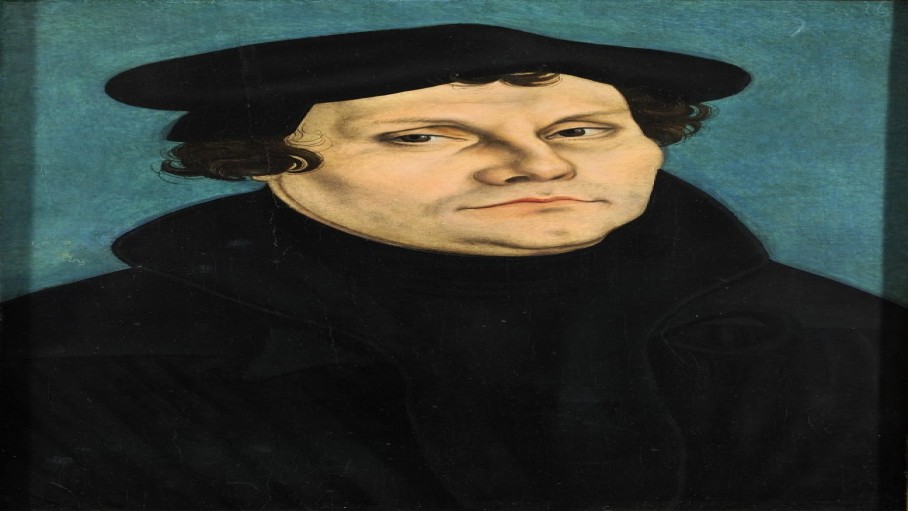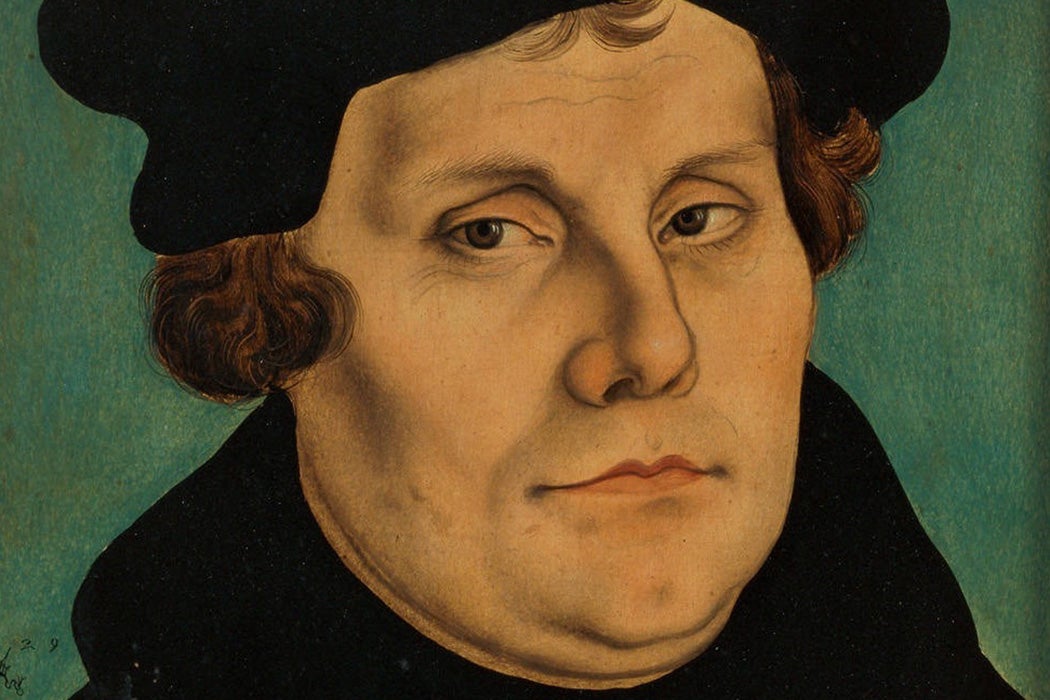
-အဘယ့်ကြောင့် မာတင်လူတာသည် ကက်သလစ်ခရစ်ယာန်အသင်းတော်ကြီးမှ ခွဲထွက်ခဲ့သနည်း။
မာတင်လူတာ၏ကက်သလစ်ခရစ်ယာန်မှ ခွဲထွက်ခဲ့ရခြင်းအကြောင်းရင်း နှင့်ပတ်သက်၍ သိကောင်းစရာ အချက်အချို့မှာ
၁။
အာဏာအလွဲသုံးစားသော အသင်းတော်ခေါင်းဆောင်များအား
ဆန့်ကျင်လိုသောကြောင့်ဖြစ်သည်ဟူသည့် အချက်သည် အများသိသော
အချက်တစ်ခုဖြစ်သည်။ သို့သော်၊ ဤအချက်သည် တစ်၀က်သာမှန်သော (half-truth)
စကားရပ်တစ်ခုသာဖြစ်သည်။ အ ကြောင်းမှာ၊ သူ၏ရဟန်းမင်းကြီးကို
ဆန့်ကျင်သည့်နောက်ကွယ်မှ အရေးကြီးဆုံးသော အချက်သည် သူ၏
ဂျာမန်လူမျိုးကြီးဝါဒ ကြောင့်ဖြစ်သည်။
၂။ မာတင်လူတာအား
ပြုပြင်ပြောင်းလဲရေးသမားကြီး - Reformer - ဟု နာမည်ပေးခဲ့ကြသည်။ သို့သော်၊
သူသည် ပြုပြင်ပြောင်းလဲရေးသမား တစ်ယောက်မဟုတ်ပေ။ သူသည်၊
ခွဲထွက်ရေးဝါဒီသမားနှင့် ခွဲထွက်ရေး ခေါင်းဆာင်ကြီးတစ်ဦးဖြစ်သည်။
အကြောင်းမှာ၊ ကက်သလစ် ခရစ်ယာန်အသင်းတော်ကြီးမှ သူသည် လုံး၀ခွဲထွက်ရန်
စိတ်ကူးမျှပင်မရှိခဲ့ ပေ။ သို့သော်၊ ရောမမြို့အုပ်ချုပ်ခံအဖြစ်မှ
လွှတ်မြောက်ကာ၊ မိမိဂျာမန် လူမျိုးများနှင့် ဖွဲ့စည်းသော၊
ဂျာမန်လူမျိုးများသာ အုပ်ချုပ်သော ကက်သလစ် ခရစ်ယာန် အသင်းတော်ကြီးကို
မြင်လိုသောကြောင့်ဖြစ်သည်။
၃။(မာကု ၁၂၊ ၁၇),.....
ဤသို့ဖြင့်၊
သူဦးဆောင်ထောက်ခံခဲ့သော ဆင်းရဲသားလယ်သမားထုအုံကြွမှုကြီးကို
လုံး၀ပစ်ထားကာ၊ ဖေါ်ကောင်လုပ်လျက်၊ သိန်းနှင့်ချီသော
ဆင်းရဲသားလယ်သမားများအား သတ်ဖြတ်သုတ်သင်စေတော့သည်။
အသက်ရှင်ကျန်ရစ်သောလယ်သ
မားများအား ညှင်းပန်းနှိပ်စက်ခြင်း၊ သူတို့ပိုင်ဆိုင်ထားသော အရာဟူသမျှကို
သိမ်းဆည်းကာ၊ သူတို့အားဖမ်းဆီးချုပ်နှောင်ခြင်းအား ဖြင့်၊
မင်းနေမင်းသားများ၊ နယ်စားမြို့စားများ၊ လယ်ပိုင်ရှင် မြေပိုင်ရှင်များ၏
ယုံကြည်မှုနှင့် ချီးမွမ်းခြင်းကိုရလေတော့သည်။ ဤသို့ဖြင့်၊ ဂျာမန်မင်း
နေမင်းသား များမှအစ၊ နယ်စားမြို့စားအဆုံး၊ မာတင်လူတာအား ဘာသာရေး
ခေါင်းဆောင် အဖြစ် မဟုတ်ဘဲ၊ ဂျာမန်လူမျိုးရေးခေါင်းဆောင်တစ်ဦးအဖြစ်
လက်ခံကာ၊ ကျောထောက် နောက်ခံ ပြုကြခြင်း ဖြစ်သည်။
၄။ ထို့ကြောင့်၊
မာတင်လူတာ၏ ကက်သလစ်ခရစ်ယာန်အသင်းတော် ကြီးမှ ခွဲထွက်ခြင်းသည် ဘာသာရေး
အတွေးအခေါ်ကြောင့် အဓိကမ ဟုတ်ဘဲ၊ ပြင်းထန်သောလူမျိုးရေး
ဝါဒကြောင့်သာဖြစ်သည်။
၅။ ဤအကြောင်းကြောင့်၊ မာတင်လူတာ၏
ခွဲထွက်ရေးဝါဒမှပေါက်ဖွား လာသော ခွဲထွက်ရေးဝါဒီ စွဲဂိုဏ်းကွဲများသည်
ဘာသာရေးနှင့် ခရစ်ယာန် သမ္မာကျမ်းစာကို လူမျိုးရေး၊ နိုင်ငံရေးအမြတ်အစွန်း
ရရှိရန် အတွက် လွယ်လင့်တကူ အသုံးပြုနေကြခြင်း ဖြစ်သည်။ မာတင်လူတာ၏ ကက်သလစ်
ခရစ်ယာန် အသင်းတော်မှ ခွဲထွက်ခြင်းအကြောင်းရင်းနှင့်ပတ်သက်၍၊ ဘာသာ
ရေးရှုတောင့် တစ်ခု တည်းမှ လေ့လာခြင်း သည် ကျဉ်းမြောင်းသောအမြင်၊
တစ်ဘက်စွန်းသောအမြင်မျိုးကို မွေးထုတ် ပေးတတ်သည်။
မာတင်လူတာ၏
၉၅ချက်ပါကြေငြာစာတမ်း (the 95 Theses) သည်ဘာသာရေး ရှုတောင့်တစ်ခုတည်းဖြင့်
ထုတ်ဝေ ခဲ့သည်မဟုတ်ပေ။ ၄င်း ၉၅ ချက်ပါ ကြေငြာစာတမ်းကိုပင် မာတင်လူတာ
ကိုယ်တိုင်ရေးသား ပြုစုခဲ့ခြင်းလည်း မဟုတ်ပေ။ သူ၏သူငယ်ချင်း Philipp
Melanchthon, a professor of Greek and a humanist (1497-1560), ကသာ
ရေးသားပြုစုခဲ့ခြင်းဖြစ်သည်။
Humanism (humanist) ဟုခေါ်သော
ထိုခေတ်ထိုခါက အတွေးအခေါ်ပိုင်းဆိုင်ရင်နိုးထမှုကြီးနှင့် ပတ်သက်၍
လေ့လာခြင်းမပြုသော သူသည် မာတင်လူတာ၏ ကက်သလစ်ခရစ်ယာန်အသင်းတော်မှ
ခွဲထွက်ခြင်းကို ဘာသာရေး တစ်ခုတည်း သက်သက်ဟုသာ မှတ်ယူလေ့ရှိသည်မှာ
ငြင်းဖွယ်မရှိချေ။ Humanism ဆိုသည်မှာ လူ၏ လွတ်လပ်ခွင့် ကိုအခြေခံသော
တက္ကဝါဒ တစ်မျိုးဖြစ်သည်။ လူတစ်ဦးချင်းစီ၏ လွတ်လပ်ခွင့် (Individual
freedom) ကို ဦးစားပေးသော တက္ကဝါဒဖြစ်သည်။
အထက်ကတင်ပြခဲ့သော အချက် ၅
ချက်သည် နိုင်ငံရေးနှင့် လူမှုရေးသမိုင်းရှုတောင့်မှ သမိုင်းပညာရှင်
ကြီးများ ၏ ရေးသားပြောကြားချက်များမှ ကောက်နှုတ်ခြင်းဖြစ်သည်။ အထူးသဖြင့်
Marius, Richard, Martin Luther: The Christian Between God and Death
(Harvard, 1999), pp. 137-139; James Harvey Robinson, Readings in
European History, 2 vols (Boston: Ginn & Company, 1906), 2: 106-108;
Steven Kreis, The History Guide: Lectures on Early Modern European
History, especially on Lecture 3: The Protestant Reformation; Lecture 4:
The Impact of Luther and Radical Protestant Reformation; from
http://www.historyguide.org/earlymod /lecture4c.html Copyright 2002
Steven Kreis Last Revised -- April 13, 2012.
မိမိနှင့်ပတ်သက်ဆက်နွယ်နေသောသမိုင်းအဖြစ်မှန်များအား
မသိကျိုးကျွံပြုခြင်းသည် ပင်စည်မှလွင့်ထွက်
ကာခြောက်သွေ့စပြုသောသစ်ရွက်နှင့်တူ၏။ ထိုသို့သောသူသည် သမိုင်းအမှား၏
ခြယ်လှယ်မှုအောင်၌ သက်ရှင်သော သူပင်ဖြစ်သည် (Michael Crichton)။
စာရေးဆရာကြီးတစ်ဦးဖြစ်သော
George Orwell ရေး သားသည်မှာ - သမိုင်းမှန်ကို ဖုံးကွယ်ကာ မေ့ပျောက် စေရန်
ကြိုးစားခြင်းသည် အလွန်အစွမ်းထက်သော ဖျက်အားကောင်း လက်နက်တစ်ခု ဖြစ်သည်ဟု
မှတ်ချက် ပြုခဲ့သည်။ ကွန်ဖြူးရှပ်စကားအရ ဆိုလျင် - အတိတ် က
သမိုင်းဖြစ်ရပ်မှန်များအား ကောင်းမွန်စွာ သင်ယူ လေ့လာခြင်း မပြုသောသူသည်
မိမိသွားရာလမ်းကို ကောင်းမွန်စွာသိနိုင်လိမ့်မည်မဟုတ်ဟု သွန်သင် ခဲ့ဖူးသည်။ သမိုင်းဖြစ်ရပ်မှန်ကိုအလေးမထား၊ သမိုင်းသည်အရေးမကြီးဟု ပြောတတ်သောသူအချို့ ရှိသည်။
(၁) ရက်စက်ကြမ်းကြုတ်သောနိုင်ငံံခေါင်းဆောင်၊ လူမျိုးခေါင်းဆောင်များ
(၂) သမိုင်းမှဖြစ်ရပ်မှန်ကို လက်ခံရန်ကြောက်ရွှံ့သောသူများ
(၃) လူမိုက်များ ဟူ၍ဖြစ်သည်။ (Crd Fr. Damian Dal)









/CharlesSpurgeonBio-463965003-551f03912d764d7db109e1c358fbcce1.jpg)



